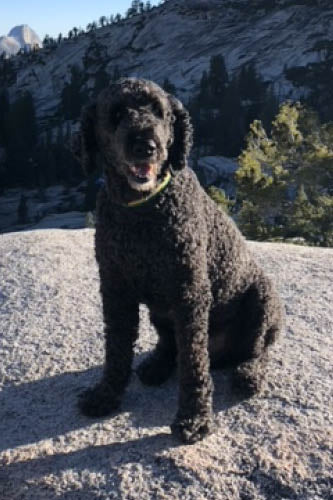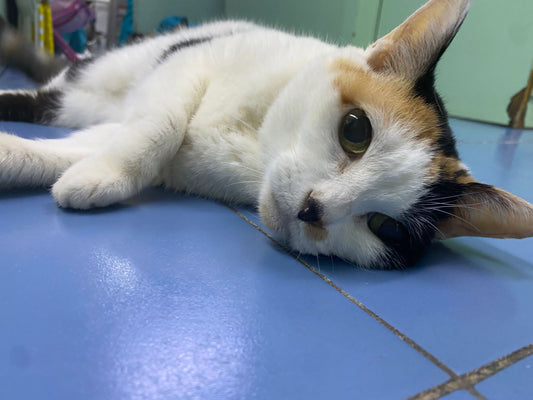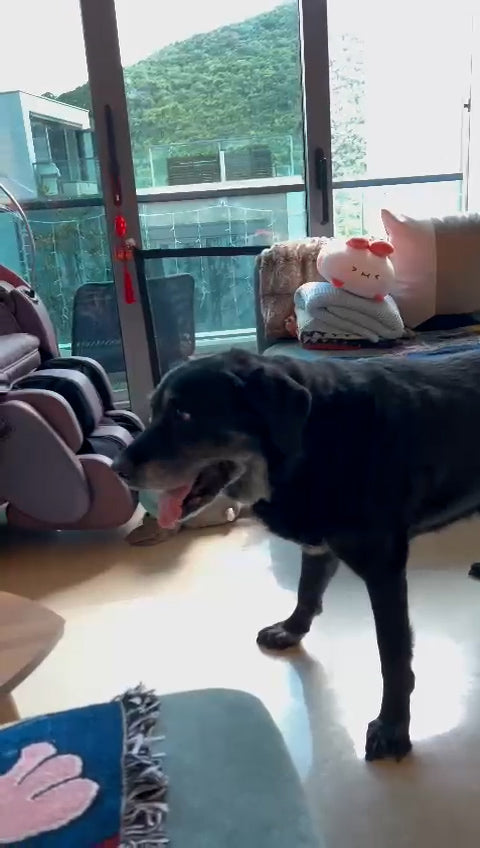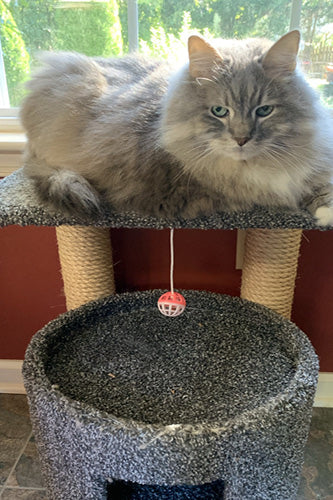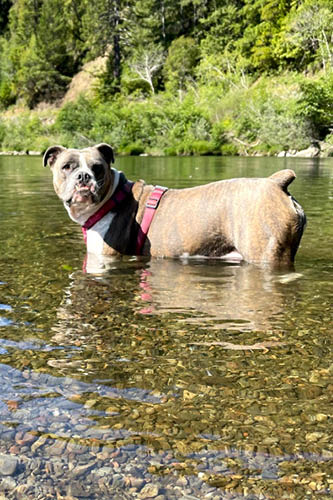Gayla and Phil adore Phoebe, their 9-year-old English cream retriever. You can hear it in their voices when they talk about her. They are brimming over with love for each other.
Phoebe is happiest when she’s swimming. She heads for a dip in the family pool, but when she was five, she had an accident that changed the course of her life.

“She jumped off the step into the pool. We think she overextended her leg or twisted her hip as she jumped; she was limping when she came out.”
“We weren't too concerned initially,” says Gayla, “but as time wore on, it was getting worse and worse. She was having more trouble getting up, and she found it hard to get comfortable when she laid down. It upset us a great deal because we don't want our dog hurting.”
Gayla and Phil go camping with their dogs, but Phoebe couldn’t get up or down into their camper van. Phil was carrying her up the four steps. And at home, she had lost all of her enthusiasm for life.
“She was really having a hard time. We have a padded rug in the front room, and that's where she loves to lay. But she couldn’t get up, I had to pick up her back end for her, and then she'd drag her back leg behind her. She had no desire to run, and walking was an effort!”

Gayla and Phil took Phoebe to the vet, but because she couldn’t be anaesthetized, they couldn’t x-ray her leg.
Gayla was keen to use natural remedies to support Phoebe’s recovery. Initially, she tried hemp oil. It seemed to help for a short while, but the impact quickly wore off.
Phil says, “Gayla was doing so much research. She worked so hard to find something natural that would work for Phoebe. Then she saw an advert for Antinol®, and she's like, ‘We're going to try this. It has excellent reviews, and people are raving about it.’ And what a world of difference it has made!”
The first 15 days with Antinol® are crucial, and it is recommended that you give your pet double the maintenance number of softgels for this period. Some pets respond quickly—90% within the first 15 days. However, some pets take a little longer. This was the case for Phoebe.
“We were counting down the days hoping she would get better, but it wasn’t instant, so Gayla got in touch with Vetz Petz via their social media. They helped us work out a plan for her, and we felt like they really went above and beyond to support us.”
“Yes”, says Gayla, “after the first month, we hadn’t seen as much change as we hoped, so I got back in touch with the Vetz Petz contact. They were fantastic. What a fantastic company! The guy said, ‘I tell you what, double up for another month, and we’ll go from there.’ Well, it was brilliant!”
“That second month made all the difference. We are overjoyed. I mean, literally overjoyed! The way she is now, she is one hundred percent better. She is a totally different dog than she was two months ago. So we are just thrilled with the results.”
Tom of Vetz Petz explains why some dogs take longer than others when starting their Antinol® Journey.
“It’s like people, no two pets are the same, and some take longer than others to show changes. This can relate to the severity of their mobility concerns, but it is also linked to the pet’s size. Larger pets may take longer for Antinol®Ⓡ to get to work in their systems. Patience is key. Persevere, and over 90% of pets will see results with Antinol®.”
“Actually,” says Phil, “Phoebe has lost around 10lbs since having Antinol®. She’s up and active now, and as a result, some weight is coming off of her.”
Phil and Gayla are delighted with the changes in Phoebe, she is back to her happy, bouncy self, and they are loving life together.
“We went from the pits of despair, worrying about her, but she is a changed dog. She is having fun, and she's healthy and just having a blast now. She trots up and down the steps to the camper, no problem. No more lifting her.”

“Yeah”, says Gayla, “we talk about it all the time. When we're in the car going somewhere, we're like, ‘Wow, isn't Phoebe doing so much better?’ And she's so much happier now. She plays again now.”
“We have a long backyard, she goes down to the very end, and we say, ‘Come on, Phoebe, it's time to go in’, and she runs to the back door. She hasn’t run like that since she was about four years old!”
Phoebe likes to get comfy, and she used to sleep sprawled out on her back, but recently her joints have made it impossible.
“She's rolling on her back again now, with her legs out. She couldn’t do that with bad legs, but now she just lies flat on her back, sprawled out, and sound asleep. It's amazing. Amazing. I can't stress amazing enough. It's amazing!”
Gayla is telling anyone who will listen about the impacts of Antinol® on Phoebe. We asked what she would say to another pet parent, worried about their furry friend’s mobility.
“I would tell them it works and to have patience. It may not be instant, but it will work. After what we saw in Phoebe, I mean, it is a dramatic change. And if you have a senior pet that’s having trouble, Antinol® is definitely worth a shot.”
“Actually, just two days ago, she surprised us. She hasn't stood on her back legs for years, and she put her front paws up on the couch. She hasn't done that forever. So we knew she was better then.
Disclaimer: These stories are for informational purposes only. The information is not a substitute for expert veterinary care. Stories are written by the Antinol team based on real interviews conducted with the pet parents and represent their own observations. These observations are not guaranteed, are not medically substantiated, and may not be typical for other pets.


